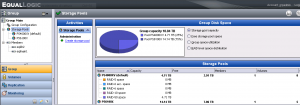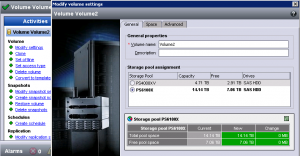During an array migration usually you can use application level trick to move your data between the old and the new array. For example with VMware vSphere you can use the Storage vMotion features (now added also in lower edition of vSphere 5.1) or with Microsoft Hyper-V 3 you can use the new Storage Live Migration feature.
But in some case you may have also an option at storage level. For example to migrate across two Dell EqualLogic array (also different models) you can use the embedded function.
 The trick its simple: just add the new EqualLogic as an additional member in you existing group (a group must always exist, also with a single member). Note that you need a minimum firmware level compatibility and usually is recommended have the same firmware level in all members of your group.
The trick its simple: just add the new EqualLogic as an additional member in you existing group (a group must always exist, also with a single member). Note that you need a minimum firmware level compatibility and usually is recommended have the same firmware level in all members of your group.
At this point when you enter in the web interface and click on the new array you have a pop-up asking to initialize the disks. Be sure to choose the desidered RAID level (remember that you can live move from RAID10 to RAID50 to RAID5 and that for SATA a RAID6 level is recommended) and a new storage pool.
![]() Each EqualLogic volume (or for other storage, each LUN) is stored on a single storage pool, as you can easy see in the volume properties.
Each EqualLogic volume (or for other storage, each LUN) is stored on a single storage pool, as you can easy see in the volume properties.
Note that a storage pool can be across more members, in this way we can have a distributed volume (in a configuration similar to a RAID0 over the network and with some auto-tiering features).
 Now you can the pool and migrate your volume, by simple change its properties and the desidered storage pool! The data migration across pools (that means also across arrays) will be start as soon is possible.
Now you can the pool and migrate your volume, by simple change its properties and the desidered storage pool! The data migration across pools (that means also across arrays) will be start as soon is possible.
It’s really easy and works at volumes level. You can make this changes on more volumes, but all those operations will be serialized in one by one.
![]() You can monitoring (and if needed also aborting) the operation at volume level, or at group level (in the operations pane).
You can monitoring (and if needed also aborting) the operation at volume level, or at group level (in the operations pane).
When all volumes have been migrated and the old storage pool is empty you can remove the old array(s) from the group (note that you can remove an array also with data on it, and the software will automatically migrate the data, but I prefer the manual migration to have more control). Now you can use the to build another group, for example for a disaster recovery site.
The main benefit is that this operation is completely at storage level without any resource consumption at storage level (although with VMware VAAI or Microsoft ODX you can mainly offload a VM data migration across datastores).
Another advantage is that is complely transpared with no needs of any reconfiguration (or new volume presentation) at host level.
This kind of migration can also preverve all storage property at volume level, like storage snapshots, storage replication, schedules and so on.











